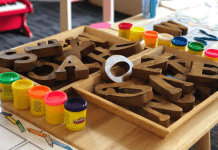As parents, we wait with bated breath for the day our sweet babies utter their first words. It’s one of the most memorable milestones for most parents. Unfortunately, our excitement can quickly be replaced with frustration or anxiety when we realize we can’t understand a word they say. Or worse, innocent words like truck or sit sound remarkably similar to four-letter words we’d rather our children not shout from the mountaintops (at least, not while we wait in line at Target). As a parent, it can be difficult to discern typical toddler speech from problematic speech patterns. Let me help ease your worried minds by answering some of the most common questions I field as a speech pathologist regarding speech sound development.
Why Can’t I Understand My Child?
Articulation is defined as the movement of the tongue, lips, soft palate, and jaw to make speech sounds. Like all areas of development, there exists a continuum of “normal” with regard to speech sound acquisition. No two children develop and progress at the same pace. Some sound substitutions and omissions are a perfectly normal part of speech sound development, while others may be indicative of a possible problem. Almost all children have some difficulty with speech sound acquisition and may temporarily simplify adult speech by implementing sound substitutions (i.e. tar for car) or omissions (i.e. ha for hat). If these sound patterns persist, an articulation disorder may be present. An articulation disorder occurs when a child has difficulty forming speech sounds, most likely due to a structural or motor-based deficit.
What Caused His Articulation Challenges?
In some cases, we can pinpoint the origin of speech sound difficulties. Speech sound disorders can be the result of motor speech disorders, structural differences (i.e. cleft palate), or sensory differences (i.e. hearing impairment). Unfortunately for parents like myself who need to know WHY THIS HAPPENED, the cause of speech sound disorders in most children is unknown.
Should I Be Worried That My Two Year Old Says Wed for Red?
Nope. Children develop speech sounds gradually — an 18 month old may only be able to pronounce the /b, m, p, w/ sounds while a three year old boasts a greater phonemic inventory. Most children can pronounce all of the speech sounds of English correctly by age eight. While each child’s speech sound acquisition is different, there are age ranges at which most children master certain sounds.
- Early sounds. Most children will use /m, n, y, b, w, d, p, and h/ correctly between 18 and 30 months. That may explain why mama, dada, and ball are frequently reported as first words.
- Middle sounds. Next to emerge are typically /t, ng, k, g, f, v, ch, and j/. You may hear your child utter these sounds appropriately as early as two, or as late as six years of age.
- Late sounds. The final group of sounds, /sh, zh, r, s, z, and th/, contains the frequent offenders when it comes to articulation disorders. They can be difficult for children to master and can wreak serious havoc on the clarity of their speech. We expect children to master these sounds between the ages of three and eight.
 If your child is using most or all of the sounds we expect for his age, his articulation development is likely on target. In other words, we absolutely do not expect a two year old to produce /r/ correctly. These types of errors are referred to as developmental sound errors. In other words, they are normal, age-appropriate errors, and they do not warrant speech therapy. If, however, your child is not using many of the sounds that are developmentally appropriate for his chronological age, consider pursuing an evaluation with a speech pathologist. For example, a three year old using only the /b, m, h, p/ sounds is NOT producing all the expected sounds for his age and could likely benefit from speech therapy.
If your child is using most or all of the sounds we expect for his age, his articulation development is likely on target. In other words, we absolutely do not expect a two year old to produce /r/ correctly. These types of errors are referred to as developmental sound errors. In other words, they are normal, age-appropriate errors, and they do not warrant speech therapy. If, however, your child is not using many of the sounds that are developmentally appropriate for his chronological age, consider pursuing an evaluation with a speech pathologist. For example, a three year old using only the /b, m, h, p/ sounds is NOT producing all the expected sounds for his age and could likely benefit from speech therapy.
No One Understands My Daughter But Me! Is That Normal?
Speech intelligibility refers to the understand-ability of one’s speech in given conditions. As adults, most of us can produce intelligible, or understandable, speech in all situations; however, we don’t expect toddlers to come out of the gate (or womb) speaking eloquently and clearly.
Keeping in mind children develop at their own unique rate, one can reasonably expect the following with regards to producing clear (ish) speech:
- Most one year olds are understood approximately 25% of the time when speaking with strangers.
- Most two year olds are understood approximately 50% of the time when speaking with strangers.
- Most three year olds are understood approximately 75% of the time when speaking with strangers
- Most four year olds are understood between 80-100% of the time when speaking with strangers.
While children are learning to speak, they WILL demonstrate sound errors. This is a normal part of phonological development and is very much expected. If you are still noticing many errors and your child isn’t easily understood by the time his third birthday rolls around, it may be advisable to consult with a speech pathologist. Alternatively, if most people can understand your two year old at least half the time, he is probably doing just fine!
I Think My Son Has a Speech Impediment. Is This Normal?
Lisping is defined as difficulty achieving the right tongue position for speech sounds like /s, z, l/. There are several different types of lisps, but the most common is the frontal, or interdental lisp. A frontal lisp occurs when the tongue tip protrudes between a child’s teeth and, subsequently, the airflow is directed forward. It can cause words like sun to sound more like thun. This type of lisp may be considered a normal part of speech acquisition. If lisping persists past your child’s 5th birthday or is distracting or troublesome to your child, don’t hesitate to pursue evaluation with a speech pathologist.
So, How Will I Know When Something Is Really Wrong?
Great question — I’m glad you asked! While keeping in mind that each child will develop in a unique way, a few indicators that your child may be experiencing difficulty with speech sound acquisition are:
- History of frequent ear infections (especially during 12-18 months of age) paired with unintelligible speech.
- Deletion of the FIRST consonant in words (i.e. at for bat).
- Vowel production errors or inconsistencies.
- Limitation of consonant and vowel sounds.
- Frustration with the inability to communicate effectively.
- Failure to be easily understood by people outside immediate family by age three.
- Use of “wet” or “slushy” speech.
Please know this quick guide is by no means meant to serve as a substitution for a true screening with a speech pathologist. If you have concerns regarding your child’s speech development, please don’t hesitate to discuss this with your child’s pediatrician in order to begin the referral process for a comprehensive evaluation with a licensed speech pathologist.













